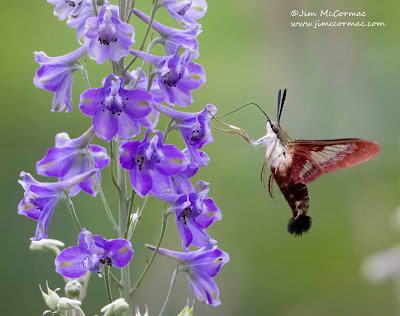Two baby house wrens peer from their nest box/Jim McCormac
Our nature writer tracked the birth of seven wrens
NATURE
Jim McCormac
Early this spring, I hung a small bird box from a pergola rafter ten feet from my kitchen window. I had high hopes that either Carolina chickadees or house wrens (both are cavity-nesters) would appropriate it. Both species are common here, the chickadees year-round and the wrens from mid-April into early October.
Right on cue, a male house wren appeared in the yard around April 20, loudly announcing himself via his rollicking, trilled song. He wasted no time investigating potential nest sites, and my new bird house was one of them.
Males typically precede females by a few days, and almost immediately begin constructing dummy nests. They stuff twigs and other material into cavities that they deem suitable nest sites. When a female appears within his turf, and they bond, she examines the male’s potential home sites and selects one.
At this point, Mrs. Wren takes over the homemaking. He is banished from the premises while she rearranges or discards his contributions, and busily adds new material.
Fortunately for me and my curiosity, she selected the bird box and I had a ringside seat to the whole nesting process. In a few days, she had whipped the nest into shape. This involved the collection of hundreds of twigs and sticks, and grasses, hair and feathers for the soft inner cup.
The typical house wren clutch ranges from four to eight eggs, and the female lays one a day. This took another week. After that, the female settled into incubation duties. The male hovered around the vicinity, often gushing enthusiastic with song, but of little help in this phase other than attacking and driving off squirrels that roamed too near the box.
After almost two weeks, it became clear that the chicks had hatched. Both parents began carting all manner of insects to the nest: lots of spiders, beetles, moths, caterpillars, flies and about anything else they could catch. I’d estimate that over 8,000 meals were delivered to the nestlings.
At first, a wren with food would disappear into the cavity. As the chicks grew and got nearer to the entrance, eventually the parents had only to stick their head inside to deliver meals. An adult’s arrival sparked a cacophony of raspy squeaks from the brood. And what goes in must come out. The adults occasionally emerged with fecal sacs – neat little bundles of baby wren effluvia. These would be flown to distant shrubs or trees and discarded.
At 6:40 am on the morning of June 24, I saw a baby wren stick its head out the hole for the first time. I knew this would be the morning of departure. The parents’ behavior changed markedly, too. The female called continually and stridently, and the male commenced regular bouts of singing, to entice them from the box. After much wide-eyed wonder at the huge new world outside its box, baby #1 launched itself at 6:55. Its flight was surprisingly strong and took it 30 feet to a redbud.
Eleven minutes later, #2 departed to another shrub. The two wrens in the accompanying photo were #3 and #4, and they left at 7:14 and 7:16 a.m. Baby #5 didn’t tarry, emerging three minutes later. Then, nothing. I began to think everyone was out, but 25 minutes later, another baby peeked out. The shrinking violet gawked out the hole for a while, then flew the coop at 7:51 a.m. And yet one more lingered, but it didn’t want to be left alone and shot out the hole a minute later.
Seven wrens! All of them disappeared into the wilds of my backyard, and I wish them the best of luck. They will need it. After feeding locally – and dodging predators – the wrenlets will undertake a lengthy and perilous southward migration that could take them all the way to Mexico.
They’ll make this journey independently, relying on an amazing built-in GPS. If all goes well in the wintering grounds, they’ll fly northward next spring and most likely return to this general area. The parents that spawned them, or one of the offspring, will probably return to my Worthington yard to produce more wrens. And the world can use more house wrens.
Naturalist Jim McCormac writes a column for The Dispatch on the first, third and fifth Sundays of the month. He also writes about nature at www.jimmccormac.blogspot.com.
%20copy.jpg)

%20copy.jpg)


%20copy.jpg)
%20copy.jpg)
.JPG)
%20copy.jpg)
